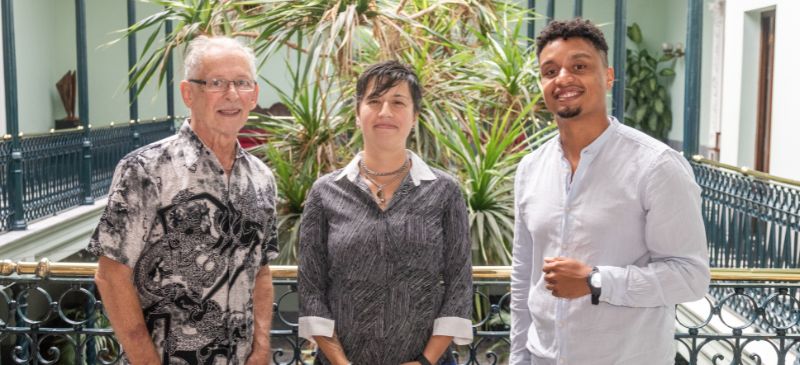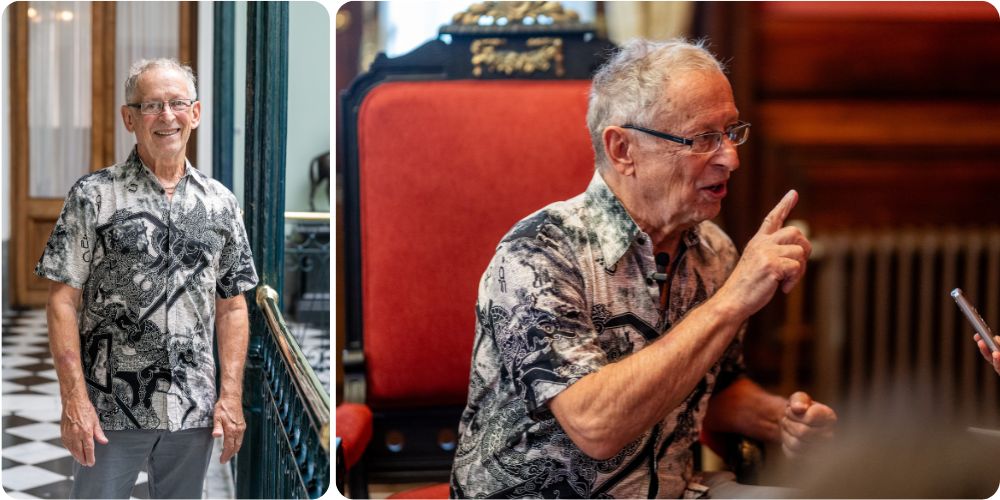- Home
- About us
- News
- Events
- EXPORT Export
-
BUY
Buy
Buy
- INVEST Invest
- COUNTRY BRAND Country Brand
-
INFORMATION CENTER
Information center
InformationCenterInformationCenterReports Country reports Department reports Foreign trade reports Product-Destination worksheet Sectors reports Work documentsStatistical information Classification Uruguay XXI Exports Imports Innovative National Effort Macroeconomic Monitor Tools Buyers Exporters Investors
- Contact
-
Languages
Uruguayan Music Brings Soul and Rhythm to Osaka
Uruguay’s Cultural Ambassadors: Maestro Hugo Fattoruso and Percussionist Mathías Silva to Represent the Nation at Expo Universal Osaka 2025
Share:

Uruguayan music is greatly represented by Hugo Fattoruso, a multi-instrumentalist, composer, and a central figure in the country’s cultural history. He brings Uruguay’s sound to a wide range of stages. This time, he will perform with the Quinteto Barrio Sur, which includes Albana Barrocas, Mathías Silva, Wellington Silva, and Guillermo Díaz Silva. Together, they will serve as cultural ambassadors at the Universal Expo Osaka 2025. Fattoruso acknowledges the immense responsibility that comes with this role, but he is equally excited about the opportunity.
“It is a pride and a responsibility that we take on naturally because, in all our trips outside of Uruguay, we know that we are representing all Uruguayans, not just the music sector,” says Fattoruso. And he acknowledges that this opportunity moves him: ”It makes my skin crawl; it gives me goosebumps.”
For him, the Uruguayan values he brings to every stage are both simple and profound. “The Uruguayan’s correctness, good manners, and friendliness are essential. Then, the music does it all,” he says.
His connection with Japan is long-standing. Having toured that country more than 24 times with Tomohiro Yahiro in the Dos Orientales project, Fattoruso highlights the respect and openness of the Japanese audience: “The Japanese audience is like a sponge, completely open to everything we have to offer. They are affectionate and enthusiastic,” he says, adding that on this occasion he will set foot on Japanese soil with Mathías Silva, Wellington Silva and Guillermo Díaz Silva, candombe icons and representatives of a family that, for more than 150 years, has kept alive one of the country’s most profound cultural expressions: the beating of the drum in the Barrio Sur of Montevideo. “There, you will hear the drums as they should be heard, with the heart and blood of candombe,” says Fattoruso.
Candombe, declared Intangible Cultural Heritage of Humanity by UNESCO, is an Afro-Uruguayan rhythm born in the streets of Montevideo. “You take a globe, poke a pin in it, and it’s in Montevideo. That’s not anywhere else in the world,” Fattoruso proudly describes the origin of this Uruguayan identity rhythm.

A meeting of drums
For the musician, the traditional Japanese percussion of the taiko and the Uruguayan candombe are different expressions but equally profound. “The taiko is a rigorous and ancient discipline with its choreography. It is not rhythmically twinned with Africa like our candombe, but seeing children and young people devote themselves to that tradition with such affection is impressive. That also unites us,” he says.
Mathías Silva, a leading light of the Cuareim 1080 troupe and heir to the family tradition, will also travel to Osaka as part of the Quinteto Barrio Sur. For him, this experience is a dream come true. “We used to play at putting together our troupe in the Barrio Sur, and today we can transcend borders with Hugo (Fattoruso). It’s incredible,” he says.
Silva feels the weight and honor of being part of a generation that is professionalizing candombe and taking it to the world. “280 years ago, those who arrived enslaved in the Barrio Sur of Montevideo played the drum to express freedom. Today, we continue to tell that story with each beat. In the last Llamadas parade — a popular celebration of drums in the streets of Montevideo — 46 groups participated when there were only eight at the beginning. “It is a movement that continues to grow and represents us,” he says.

According to Silva, previous experiences with the Japanese, who came to learn candombe with the Cuareim 1080 troupe, were revealing. “The Japanese ambassador came to learn, and within three months, she was out on the parade with us. The language of the drum is universal. By playing, we will understand each other,” he says when asked about his expectations of participating in Expo Osaka 2025.
The show they will present in Osaka will be a meeting of cultures. “We are waiting to confirm the presence of dancers, mama vieja and gramillero —traditional figures of candombe—. In addition, Japanese friends will strap on a drum and play with us for the first time. That will be part of the integration,” Fattoruso reveals.
Both agree that this will be one of the highlights of their careers. “Playing with them (the Silva family) in Japan is an incredible joy. We know that what they will witness is the best of the best,” says Fattoruso.
For Silva, the moment will be charged with emotion and gratitude. “The tool my father left us was the drum. Our whole life revolves around the drum, but we also use it as an excuse to do social work and cultural work. That’s why representing Uruguay in the world is the fulfillment of a lifelong dream. We deeply appreciate this opportunity to Uruguay XXI and to all the companies, institutions, and organizations that will support us. Rest assured that we will do it with the utmost responsibility because we are fulfilling a dream of our own and our culture,” he acknowledged.
These musicians' message to the Japanese public is clear and simple: " Thank you very much. I know you are going to love it,” says Fattoruso. Silva closes with emotion: “We are going to do our bit by bringing our culture, which I think is one of the best ways to represent Uruguay.”
